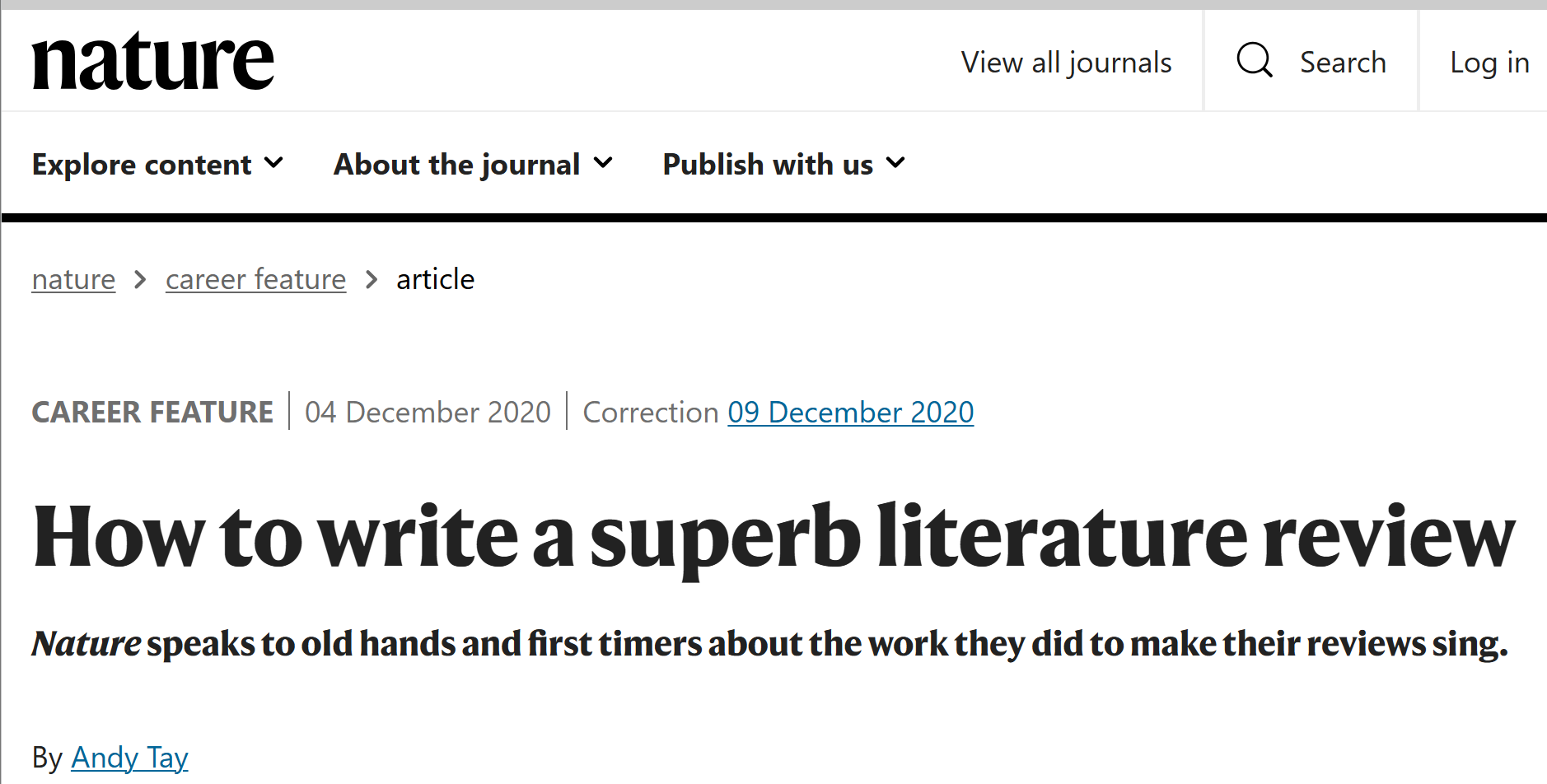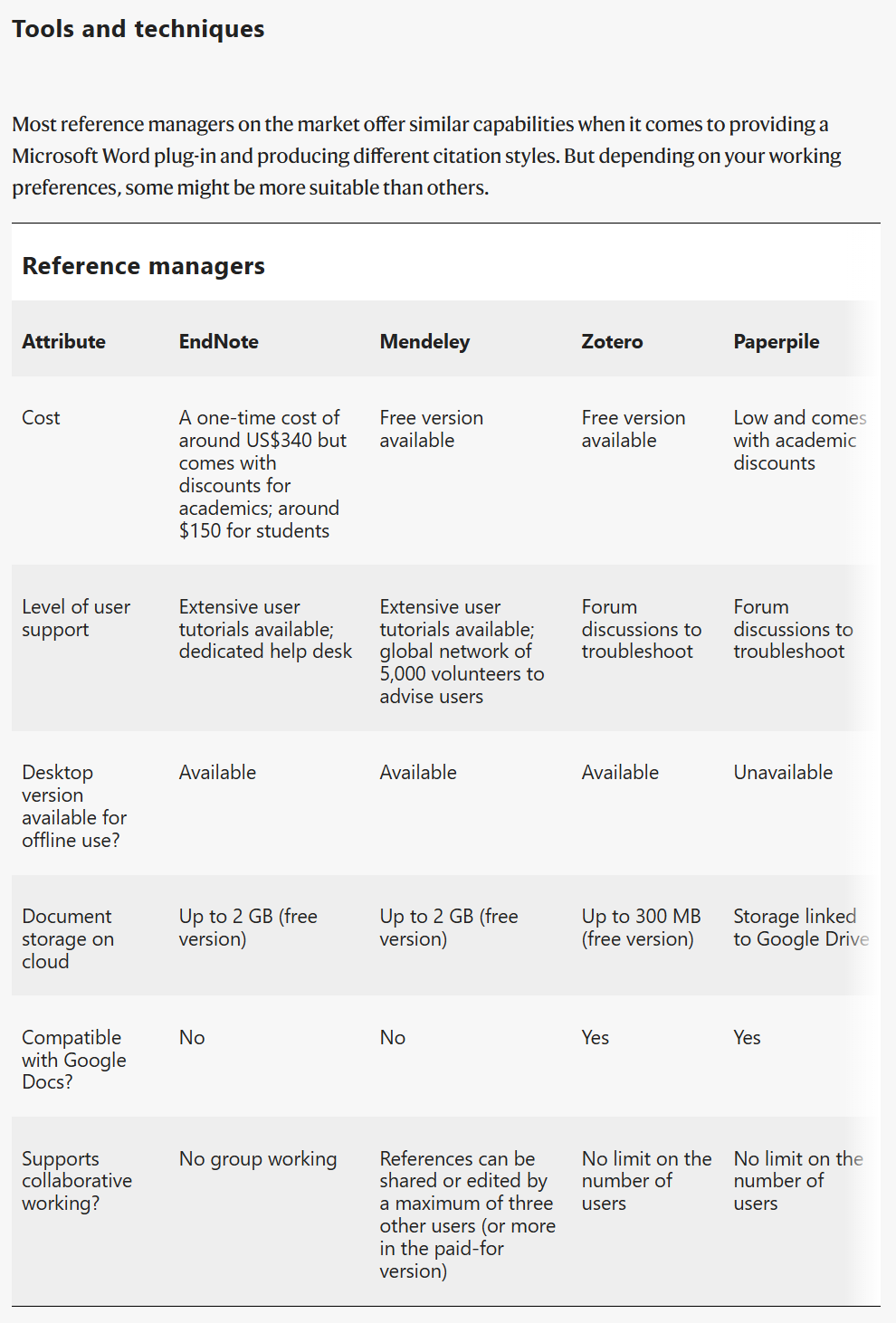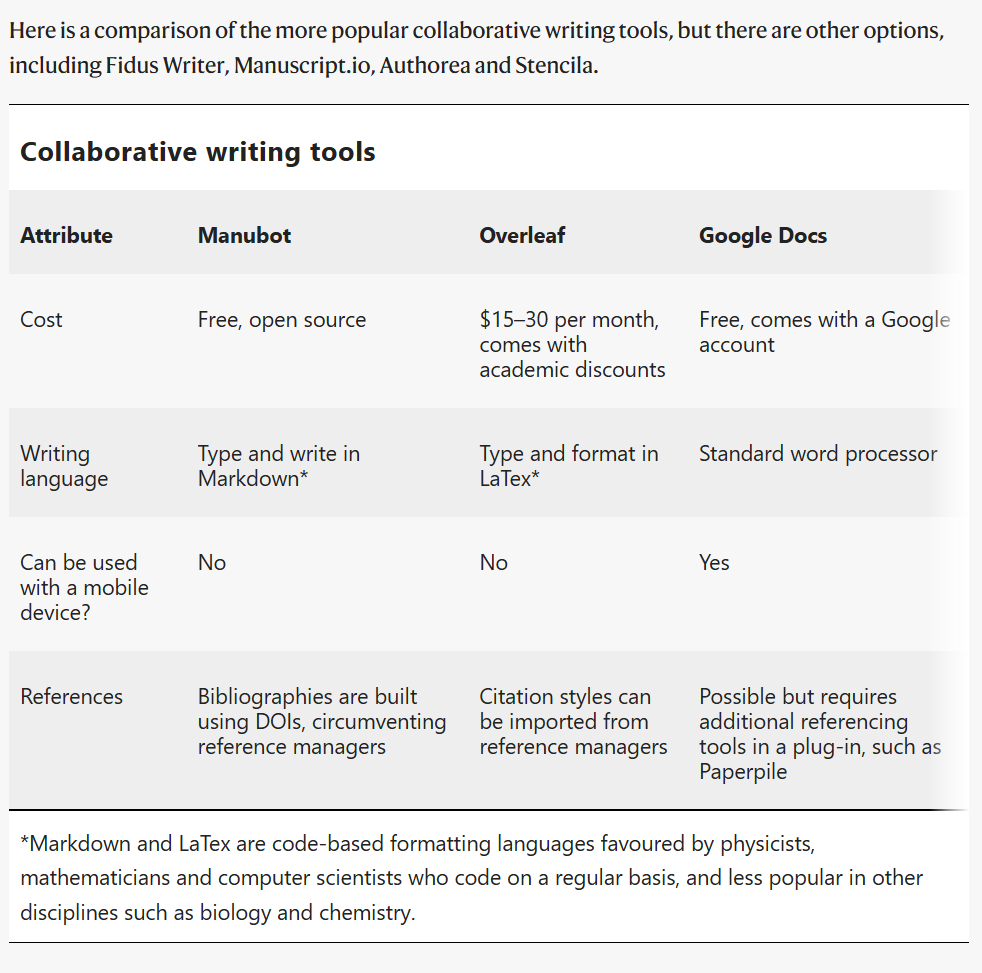先上干货总结
实用建议
- 综述写作有助于理解研究领域的历史,并激发新的研究想法。
- 综述写作可以帮助培养早期职业研究人员的项目管理和领导力等软技能。
- 优秀的综述提案应时效性强,并清楚解释为什么读者应关注所提议的主题。
- 写作综述时,必须跟上文献的最新进展。
- 撰写综述时避免过于雄心勃勃,求大求全, 应专注于讨论,避免使用术语。
- 将自己想象成“科学的艺术家”,并发展自己的写作和呈现信息的方式。
- 综述图表比想象的更重要,可以用于说明科学概念。
- 学会接受批评以提高工作的价值和读者群。
- 利用技术(如编程)来提高文献搜索的效率。
工具与技术
- 文献管理工具比较:EndNote、Mendeley、Zotero、Paperpile。
- 协作写作工具:Manubot、Overleaf、Google Docs。
原文:

doi: https://doi.org/10.1038/d41586-020-03422-x
WENTING ZHAO: Be focused and avoid jargon
Assistant professor of chemical and biomedical engineering, Nanyang Technological University, Singapore.
When I was a research student, review writing improved my understanding of the history of my field. I also learnt about unmet challenges in the field that triggered ideas.
For example, while writing my first review as a PhD student, I was frustrated by how poorly we understood how cells actively sense, interact with and adapt to nanoparticles used in drug delivery. This experience motivated me to study how the surface properties of nanoparticles can be modified to enhance biological sensing. When I transitioned to my postdoctoral research, this question led me to discover the role of cell-membrane curvature, which led to publications and my current research focus. I wouldn’t have started in this area without writing that review.
A common problem for students writing their first reviews is being overly ambitious. When I wrote mine, I imagined producing a comprehensive summary of every single type of nanomaterial used in biological applications. It ended up becoming a colossal piece of work, with too many papers discussed and without a clear way to categorize them. We published the work in the end, but decided to limit the discussion strictly to nanoparticles for biological sensing, rather than covering how different nanomaterials are used in biology.
My advice to students is to accept that a review is unlike a textbook: it should offer a more focused discussion, and it’s OK to skip some topics so that you do not distract your readers. Students should also consider editorial deadlines, especially for invited reviews: make sure that the review’s scope is not so extensive that it delays the writing.
A good review should also avoid jargon and explain the basic concepts for someone who is new to the field. Although I trained as an engineer, I’m interested in biology, and my research is about developing nanomaterials to manipulate proteins at the cell membrane and how this can affect ageing and cancer. As an ‘outsider’, the reviews that I find most useful for these biological topics are those that speak to me in accessible scientific language.
BOZHI TIAN: Have a process and develop your style
Associate professor of chemistry, University of Chicago, Illinois.
In my lab, we start by asking: what is the purpose of this review? My reasons for writing one can include the chance to contribute insights to the scientific community and identify opportunities for my research. I also see review writing as a way to train early-career researchers in soft skills such as project management and leadership. This is especially true for lead authors, because they will learn to work with their co-authors to integrate the various sections into a piece with smooth transitions and no overlaps.
After we have identified the need and purpose of a review article, I will form a team from the researchers in my lab. I try to include students with different areas of expertise, because it is useful to get a variety of perspectives. For example, in the review ‘An atlas of nano-enabled neural interfaces’, we had authors with backgrounds in biophysics, neuroengineering, neurobiology and materials sciences focusing on different sections of the review.
After this, I will discuss an outline with my team. We go through multiple iterations to make sure that we have scanned the literature sufficiently and do not repeat discussions that have appeared in other reviews. It is also important that the outline is not decided by me alone: students often have fresh ideas that they can bring to the table. Once this is done, we proceed with the writing.
I often remind my students to imagine themselves as ‘artists of science’ and encourage them to develop how they write and present information. Adding more words isn’t always the best way: for example, I enjoy using tables to summarize research progress and suggest future research trajectories. I’ve also considered including short videos in our review papers to highlight key aspects of the work. I think this can increase readership and accessibility because these videos can be easily shared on social-media platforms.
ANKITA ANIRBAN: Timeliness and figures make a huge difference
Editor, Nature Reviews Physics_._
One of my roles as a journal editor is to evaluate proposals for reviews. The best proposals are timely and clearly explain why readers should pay attention to the proposed topic.
It is not enough for a review to be a summary of the latest growth in the literature: the most interesting reviews instead provide a discussion about disagreements in the field.
Scientists often centre the story of their primary research papers around their figures — but when it comes to reviews, figures often take a secondary role. In my opinion, review figures are more important than most people think. One of my favourite review-style articles presents a plot bringing together data from multiple research papers (many of which directly contradict each other). This is then used to identify broad trends and suggest underlying mechanisms that could explain all of the different conclusions.
An important role of a review article is to introduce researchers to a field. For this, schematic figures can be useful to illustrate the science being discussed, in much the same way as the first slide of a talk should. That is why, at Nature Reviews, we have in-house illustrators to assist authors. However, simplicity is key, and even without support from professional illustrators, researchers can still make use of many free drawing tools to enhance the value of their review figures.
YOOJIN CHOI: Stay updated and be open to suggestions
Research assistant professor, Korea Advanced Institute of Science and Technology, Daejeon.
I started writing the review ‘Biosynthesis of inorganic nanomaterials using microbial cells and bacteriophages’ as a PhD student in 2018. It took me one year to write the first draft because I was working on the review alongside my PhD research and mostly on my own, with support from my adviser. It took a further year to complete the processes of peer review, revision and publication. During this time, many new papers and even competing reviews were published. To provide the most up-to-date and original review, I had to stay abreast of the literature. In my case, I made use of Google Scholar, which I set to send me daily updates of relevant literature based on key words.
Through my review-writing process, I also learnt to be more open to critiques to enhance the value and increase the readership of my work. Initially, my review was focused only on using microbial cells such as bacteria to produce nanomaterials, which was the subject of my PhD research. Bacteria such as these are known as biofactories: that is, organisms that produce biological material which can be modified to produce useful materials, such as magnetic nanoparticles for drug-delivery purposes.
However, when the first peer-review report came back, all three reviewers suggested expanding the review to cover another type of biofactory: bacteriophages. These are essentially viruses that infect bacteria, and they can also produce nanomaterials.
The feedback eventually led me to include a discussion of the differences between the various biofactories (bacteriophages, bacteria, fungi and microalgae) and their advantages and disadvantages. This turned out to be a great addition because it made the review more comprehensive.
Writing the review also led me to an idea about using nanomaterial-modified microorganisms to produce chemicals, which I’ m still researching now.
PAULA MARTIN-GONZALEZ: Make good use of technology
PhD student, University of Cambridge, UK.
Just before the coronavirus lockdown, my PhD adviser and I decided to write a literature review discussing the integration of medical imaging with genomics to improve ovarian cancer management.
As I was researching the review, I noticed a trend in which some papers were consistently being cited by many other papers in the field. It was clear to me that those papers must be important, but as a new member of the field of integrated cancer biology, it was difficult to immediately find and read all of these ‘seminal papers’.
That was when I decided to code a small application to make my literature research more efficient. Using my code, users can enter a query, such as ‘ovarian cancer, computer tomography, radiomics’, and the application searches for all relevant literature archived in databases such as PubMed that feature these key words.
The code then identifies the relevant papers and creates a citation graph of all the references cited in the results of the search. The software highlights papers that have many citation relationships with other papers in the search, and could therefore be called seminal papers.
My code has substantially improved how I organize papers and has informed me of key publications and discoveries in my research field: something that would have taken more time and experience in the field otherwise. After I shared my code on GitHub, I received feedback that it can be daunting for researchers who are not used to coding. Consequently, I am hoping to build a more user-friendly interface in a form of a web page, akin to PubMed or Google Scholar, where users can simply input their queries to generate citation graphs.


文章来源:
https://www.nature.com/articles/d41586-020-03422-x
























 2823
2823

 被折叠的 条评论
为什么被折叠?
被折叠的 条评论
为什么被折叠?








